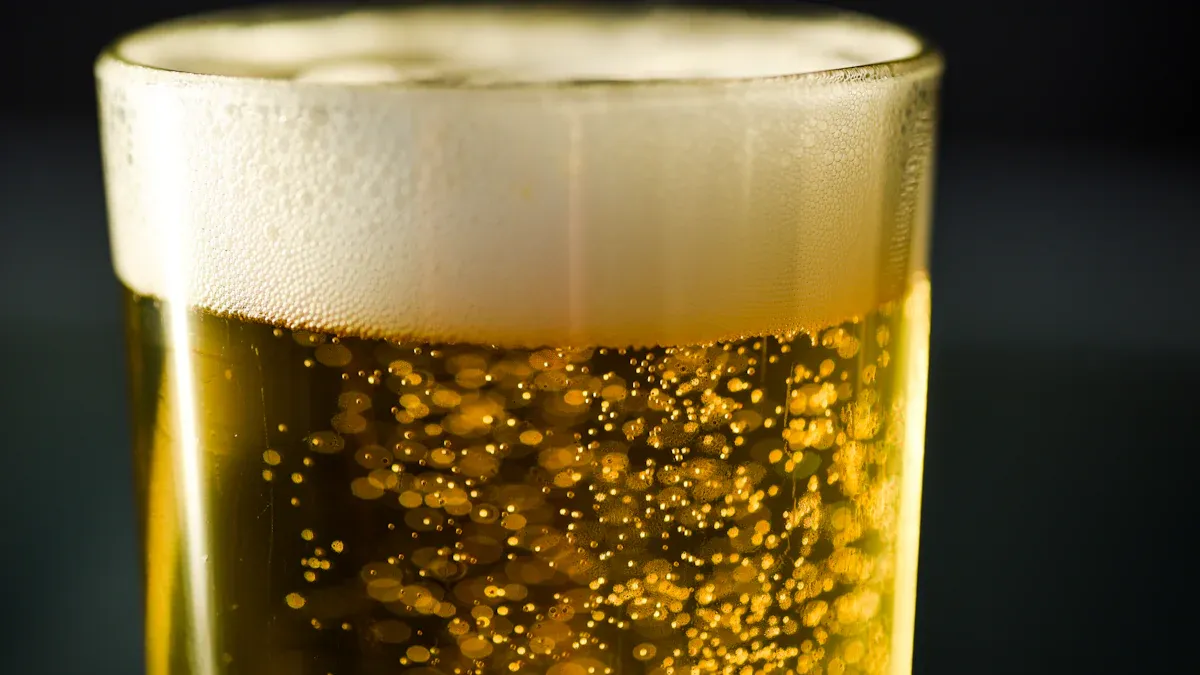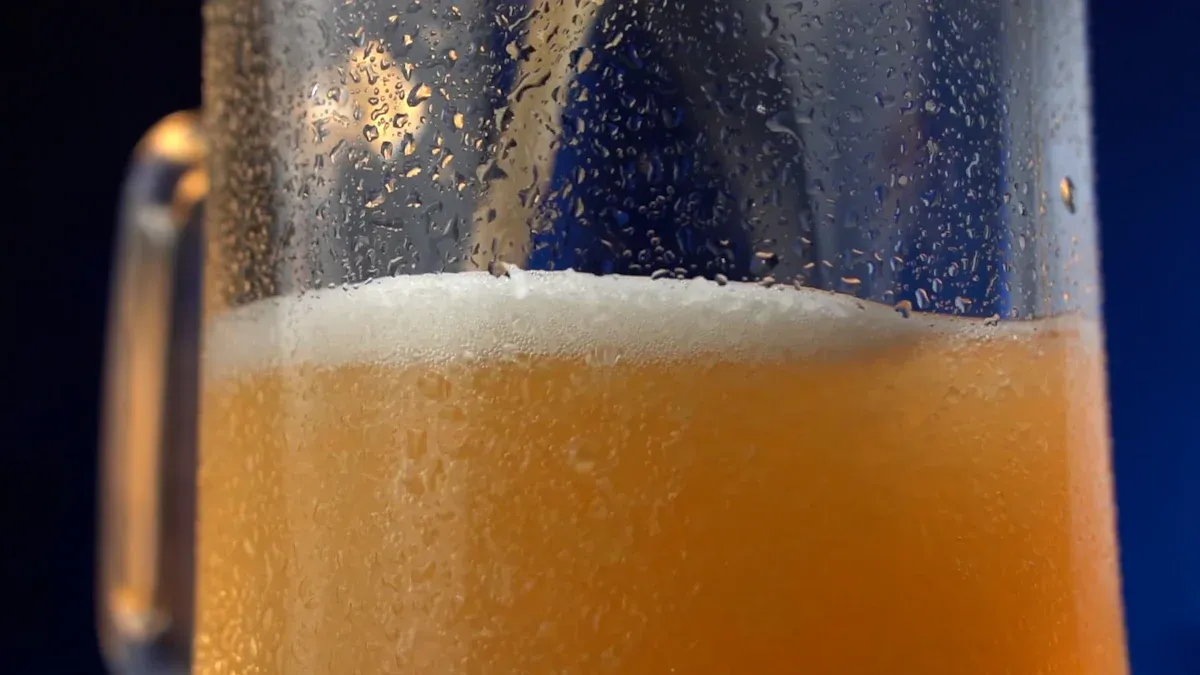
Yes, beer is carbonated, which means it contains bubbles like soda. The carbonation in beer comes from carbon dioxide produced during fermentation. These tiny bubbles remain in the beer until you open the bottle or pour it into a glass. When you drink beer, you can feel the fizzy bubbles, which is why many people wonder, is beer carbonated? This fizz is what makes beer unique and different from other beverages. Each type of beer offers its own distinct bubbly sensation.
Key Takeaways
Beer is fizzy because it has carbon dioxide bubbles from fermentation. Yeast makes CO2 in beer, which causes small, gentle bubbles. Forced carbonation puts CO2 in beer with pressure, making bigger bubbles and a sharp fizz. Carbonation changes how beer tastes, smells, and feels by bringing out flavors and making foam. Each beer style has its own amount of carbonation, so each one feels different and bubbly.
Is Beer Carbonated
Why Beer Is Fizzy
When you ask, "is beer carbonated," you are really asking about the bubbles you see and feel in your drink. You notice the fizz as soon as you pour beer into a glass. This fizz comes from tiny bubbles of carbon dioxide, or CO2. These bubbles rise to the top and create the foam, or head, that sits on your beer.
You experience carbonation every time you drink a carbonated drink like beer or soda. The bubbles tickle your tongue and make the drink feel lively. Carbonation gives beer its refreshing quality. Without it, beer would taste flat and dull.
Did you know? The fizz in beer is not just for fun. It helps carry the aroma to your nose, making each sip more flavorful.
You might wonder why some beers feel more bubbly than others. The answer lies in how much CO2 is dissolved in the liquid. Some beer styles have high carbonation, while others have less. When you open a bottle or can, the pressure drops, and CO2 escapes as bubbles. This is the science behind beer carbonation.
CO2 and Fermentation
You may ask, "How does CO2 get into beer?" The answer starts with the beer fermentation process. When yeast eats the sugars in the grains, it produces alcohol and carbon dioxide. This natural process happens in almost every beer.
Here’s a simple breakdown of what happens during fermentation:
Yeast is added to the beer mixture.
Yeast eats the sugars and creates alcohol.
CO2 forms as a byproduct and gets trapped in the beer.
You can think of beer as a carbonated drink because of this trapped CO2. Brewers sometimes add extra CO2 to make the beer even more carbonated. This step increases the fizz and makes the beer feel more lively.
Step | What Happens | Result in Beer |
Add yeast | Yeast eats sugars | Alcohol and CO2 form |
Trap CO2 | CO2 stays in the liquid | Beer becomes carbonated |
Open bottle | CO2 escapes as bubbles | Fizz and foam appear |
You now know that CO2 is the key to carbonation in beer. Every time you enjoy a cold beer, you taste the result of fermentation and the bubbles that make it special. The next time someone asks, "is beer carbonated," you can explain how CO2 and the beer fermentation process work together to create that fizzy, refreshing experience.
Carbonation Methods
![Carbonation Methods]()
When you drink something fizzy, you may wonder about the bubbles. In beer, there are two main ways to get carbonation. These are natural carbonation and forced carbonation. Both ways use CO2, but the steps are not the same. The taste and feel can also change.
Natural Carbonation
Natural carbonation happens during fermentation. Yeast eats sugar in the beer and makes alcohol and CO2. Brewers keep the CO2 inside the container. This makes the gas mix with the liquid. This way gives beer a soft and smooth feel. The bubbles are smaller and feel gentle on your tongue.
Tip: If you like creamy foam, try beers with natural carbonation. CO2 from fermentation helps make a thick, lasting head.
Many old-style beers use natural carbonation. Bottle-conditioned beers often use this method too. Brewers add a little sugar before closing the bottle. The yeast eats the sugar and makes more CO2. The gas stays inside until you open the bottle.
Forced Carbonation
Forced carbonation is a different method. Brewers put CO2 straight into the beer under pressure. This way is common in big breweries. It works fast and lets brewers control the fizz. Forced carbonation gives beer a crisp and lively fizz.
Here is a quick comparison:
Method | How CO2 Gets In | Bubble Size | Taste and Feel |
Natural Carbonation | From fermentation | Finer | Softer, smoother |
Forced Carbonation | CO2 added under pressure | Larger | Sharper, crisper |
You may see that forced carbonation makes bigger bubbles. The fizz feels stronger. Many sodas use this method too. Most beers made in factories use forced carbonation. This helps every bottle taste the same.
Note: Both ways use CO2, but the bubbles can feel different. Try different beers to find which kind of carbonation you like best.
Effects of Carbonation
Taste and Aroma
When you drink beer, carbonation changes how you taste and smell it. The bubbles lift flavors and aromas from the liquid. As carbonation rises, it carries tiny drops of beer to your nose. This action helps you notice the scent before you even take a sip. You might find that a beer with more carbonation smells stronger and fresher.
Carbonation also affects the taste. The bubbles can make the beer taste crisp or sharp. Some people say that carbonation adds a slight bite to each sip. If you try a beer with low carbonation, you may notice the flavors feel softer and less lively. High carbonation can highlight fruity or spicy notes in some beer styles.
Tip: Swirl your glass gently to release more aroma. Carbonation helps bring out the best scents in your beer.
Mouthfeel and Foam
You feel carbonation as soon as the bubbles hit your tongue. The sensation can range from a gentle tickle to a strong fizz. This feeling is called mouthfeel. Beers with pronounced carbonation often feel lively and refreshing. The bubbles make your mouth feel clean after each sip.
Foam, or head, forms when carbonation escapes from the beer. The bubbles rise and create a layer on top of your drink. This foam does more than look pretty. It traps aromas and keeps them close to your nose. A good head also protects the beer from air, which helps keep the flavors fresh.
Here is a quick look at how carbonation changes your drinking experience:
Carbonation Level | Mouthfeel | Foam Quality |
Low | Smooth, soft | Thin, short-lived |
Medium | Balanced, lively | Stable, creamy |
High | Sharp, fizzy | Thick, lasting |
You can see how carbonation shapes every part of your beer experience. Next time you pour a glass, watch the bubbles and notice how they change the taste, aroma, and feel.
Carbonation in Beer Styles
![Carbonation in Beer Styles]()
High vs. Low Carbonation
Beer can have different amounts of carbonation. Some beers have lots of bubbles, while others have fewer. Beers with high carbonation feel crisp and lively. Wheat beers, Belgian ales, and pilsners are good examples. These beers have many bubbles that tickle your tongue. The bubbles help bring out the flavors and make each sip refreshing.
Beers with low carbonation feel smooth and soft. English ales, stouts, and porters usually have less carbonation. These beers taste creamy and gentle. The flavors can seem richer and more mellow. Some people like low carbonation because it is easier on the stomach. If your stomach is sensitive, you might like these beers more.
Here is a table to help you compare:
Beer Style | Carbonation Level | Mouthfeel |
Wheat Beer | High | Crisp, lively |
Belgian Ale | High | Effervescent |
Pilsner | High | Refreshing |
English Ale | Low | Smooth, soft |
Stout | Low | Creamy, mellow |
Porter | Low | Gentle, rich |
Tip: Pick a beer with high carbonation if you want a fizzy drink. For a smoother taste, try a beer with low carbonation.
Non-Carbonated Beers
Some beers do not have bubbles at all. A few old styles have little or no carbonation. Cask ales, also called "real ales," use very low carbonation. Brewers serve these beers from a cask without extra gas. You get a smooth and flat taste. Some people like non-carbonated beers because they do not cause bloating or fizz.
You can also find special beers made without carbonation on purpose. These beers let you taste the pure flavors without bubbles. If you want to try something new, pick a non-carbonated beer. You will see how much carbonation changes the way beer tastes and feels.
Natural vs. forced carbonation in beer
When you drink something fizzy, you might wonder about the bubbles. In beer, there are two main ways to get carbonation. These are natural carbonation and forced carbonation. Both ways use co2, but the steps are not the same. The taste and feel can also change.
Natural carbonation happens during fermentation. Yeast eats sugar in the beer and makes alcohol and co2. Brewers keep the co2 inside the container. This makes the gas mix with the liquid. This way gives beer a soft and smooth feel. The bubbles are smaller and feel gentle on your tongue. Many old-style beers use natural carbonation. Bottle-conditioned beers often use this method too. Brewers add a little sugar before closing the bottle. The yeast eats the sugar and makes more co2. The gas stays inside until you open the bottle.
Forced carbonation is a different method. Brewers put co2 straight into the beer under pressure. This way is common in big breweries. It works fast and lets brewers control the fizz. Forced carbonation gives beer a crisp and lively fizz. Most beers made in factories use forced carbonation. This helps every bottle taste the same.
Here is a quick comparison:
Method | How co2 is added | Bubble Size | Taste and Feel |
Natural carbonation | Produced by yeast | Small | Soft, smooth |
Forced carbonation | Pumped in under pressure | Large | Crisp, lively |
Tip: If you like creamy foam, try beers with natural carbonation. For a sharp, sparkling taste, pick one with forced carbonation.
You can notice the difference between these two ways. Natural carbonation brings out softer flavors. Forced carbonation gives a bright and fresh finish. Next time you drink beer, think about how co2 and bubbles change your experience.
Most beers get their fizz from CO2, either made during fermentation or added later. Carbonation changes how beer tastes, smells, and feels in your mouth. Next time you pour a glass, watch the bubbles rise and notice the foam.
Take a moment to enjoy the sparkle and the way carbonation brings out the best in your beer.
FAQ
What causes the bubbles in beer?
You see bubbles in beer because of carbon dioxide (CO2). Yeast creates CO2 during fermentation. When you open a bottle or can, the gas escapes and forms bubbles.
Can you drink flat beer?
You can drink flat beer, but it tastes different. Flat beer has lost its carbonation. The flavors may seem dull. Some people enjoy it, but most prefer beer with fizz.
Does all beer have the same amount of carbonation?
No, different beers have different carbonation levels. Wheat beers and pilsners have more bubbles. Stouts and porters have less. Each style gives you a unique drinking experience.
Why does beer foam up when you pour it?
Beer foams up because CO2 escapes quickly when you pour. The bubbles rise and create a head. Pouring slowly down the side of the glass helps control the foam.






























